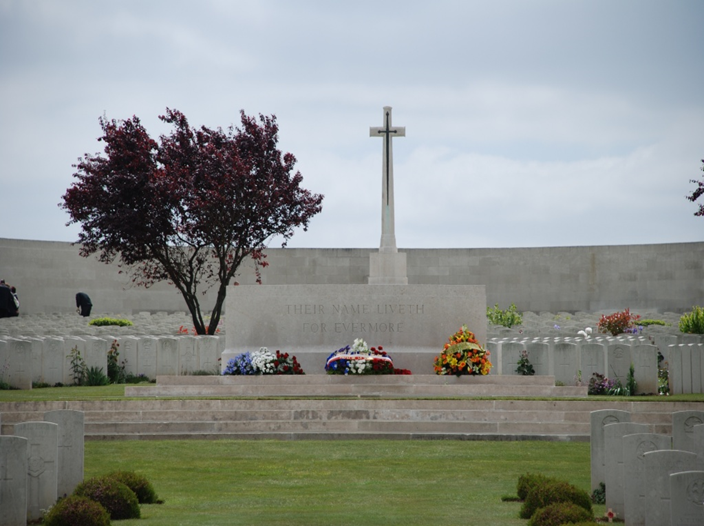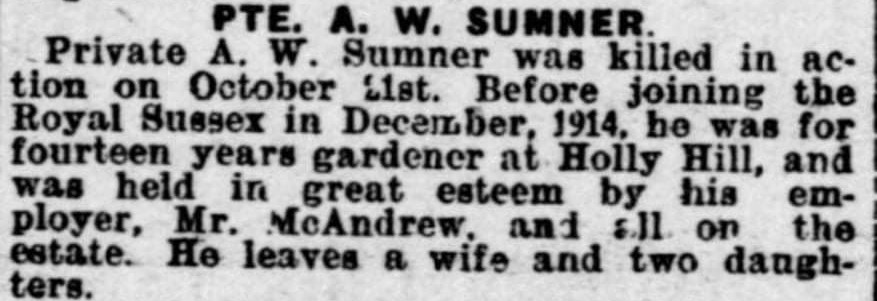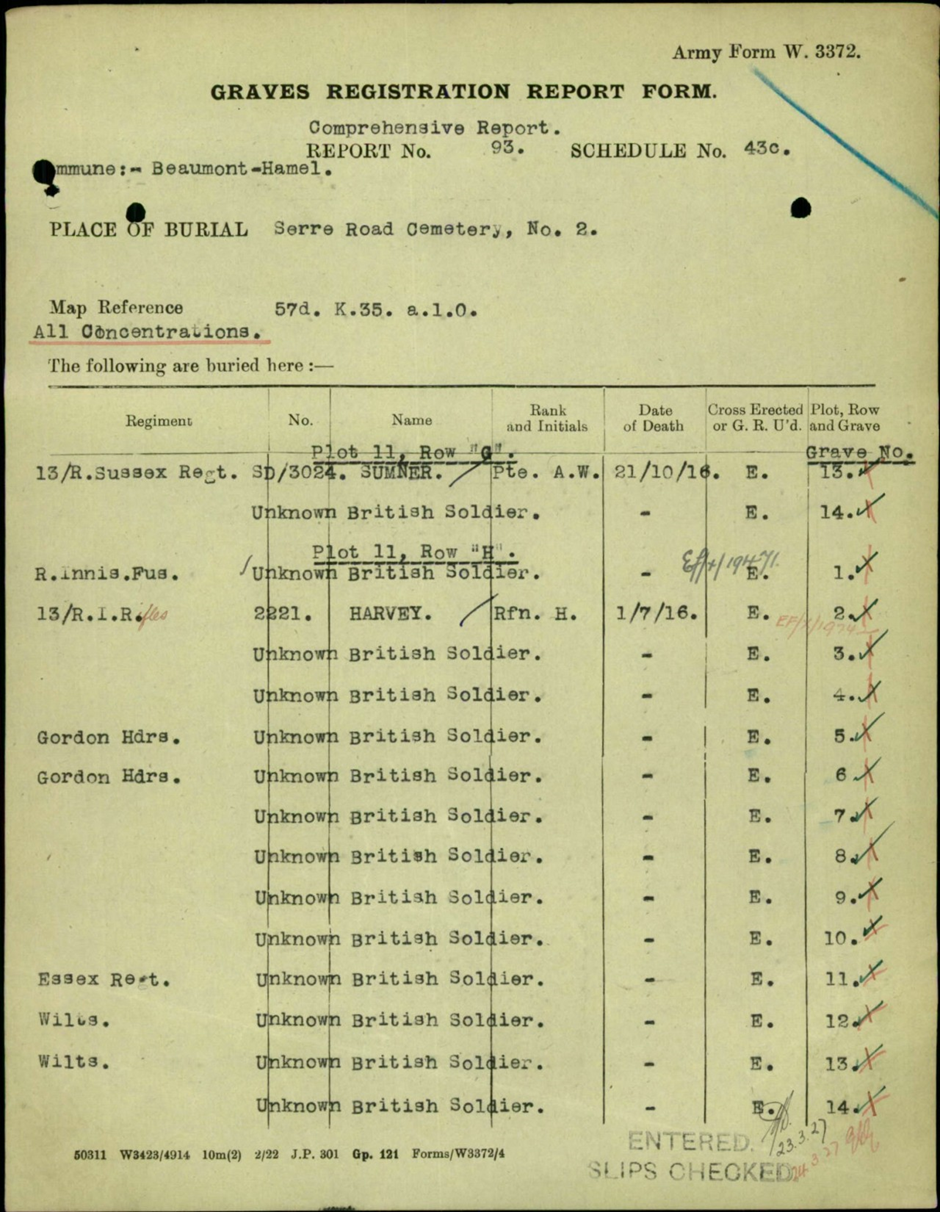ALFRED WILLIAM SUMNER
Private, SD/3024, 13th Battalion, Royal Sussex Regiment
Killed in Action on 21 October 1916 near Serre, Somme, France, aged 39
Buried in Serre Road Cemetery No.2, Somme, France: Grave XI. C. 13
Alfred Sumner
Click to enlarge
Private Alfred William Sumner was born in 1877 at Claytons in Ashurst, Kent (about 2½ miles north-east of Hartfield) and later lived at 2, New Red House, Cat Street, Hartfield, the son of Albert and Katherine (née Card) Sumner. His father, Albert, was an agricultural labourer who was born in Frant, Sussex, around 1845. His mother, Catherine, was considerably older than his father, having been born in Withyham, Sussex, in December 1838. Albert and Catherine married in 1865, with a son, Albert George, being born the following year.
Alfred William had two elder sisters, Sarah (born 1867) and Kate (born 1873). Kate was still living with her parents in 1911, aged 38, and is listed as a domestic servant in Groombridge, Sussex. In 1901 she was working as a housemaid in Wimbledon for Captain John Todd and his wife Mary. His eldest sister Sarah was married in 1884 to George Simmons but continued to live in the area; her husband was a general labourer and they had 11 children by 1911.

This is believed to be a photograph of the Red House, Cat Street, Hartfield.
The Sumners lived in the right-hand property.
(Click to enlarge)
Alfred William married Emma Jane Sumner (née Allchin, and later Crittenden) in 1899, and they had the following children: Edith, born in 1900, and Florence, born in 1902. His pre-war occupation was as a gardener. The Hartfield War Memorial website implies he may have worked for John McAndrew, a shipping magnate who owned Holly Hill and built Holy Trinity, Coleman's Hatch, in 1913, and this appears to be confirmed by a local newspaper report of his death which adds that he was a gardener at Holly Hill for fourteen years — see below.

The 13th Battalion, the Royal Sussex Regiment,
at Witley Camp, Surrey, 1916
(Click to enlarge)
Alfred William enlisted in the Royal Sussex Regiment at Eastbourne in December 1914. He was serving on the Somme in the autumn of 1916 and was killed in action on 21 October 1916 near Thiepval. He was aged 39 and left a wife and two teenage children. Subsequently his widow, Emma Jane, married Percy Crittenden in 1919 and she died in 1955, aged 79. Percy's occupation was documented as a carman in the 1911 census and he was also previously married to Sarah; he lived at Green Cottage, Hartfield, with his wife and five children. Sarah died in March 1917 aged 40. Percy was recorded as a gardener in 1939.

The Schwaben Redoubt, near Thiepval, Picardy
Alfred William Sumner was killed during an attack at the Schwaben Redoubt near Thiepval, Picardy. The redoubt had been built as part of the fortification of the Somme front by the German 2nd Army (General Fritz von Below) after the open warfare of 1914. It had deep dug-outs for accommodation with multiple entrances, a battalion command post, first aid post, signalling station and strong points, with three heavy machine-guns and four light machine-guns. Many of the dug-outs were on the perimeter, at trench junctions (clockwise from north, using the English names), Irwin Trench (strong points 49 and 69), Lucky Way (strong point 27), Stuff Trench, Hessian Trench (strong point 45), Martin's Lane, the Strasburg Line (strong point 19) and Clay Trench (strong point 99). Inside the redoubt, along an inner trench on the south-west face were strong points 65, 37 and 39. Beyond the south-west face, in the maze of trenches towards Thiepval to the south and St. Pierre Division to the north-west, were nine more strong points.[10] The redoubt was triangular, with an extension to the east across the Thiepval-Grandcourt road and had a frontage of around 500 metres (550 yds).

Serre Road Cemetery No.2
(Click to enlarge)
On 1 July, the first day of the Somme, troops of the 36th (Ulster) Division occupied part of the redoubt before being forced to retreat by German counter-attacks. British troops were not able to reach the redoubt again until the Battle of Thiepval Ridge (26-28 September), when parties of the 11th Division captured part of it. The rest of the redoubt was taken by the 25th Division during the Battle of the Ancre Heights (1 October-11 November).
The 13th Battalion of the Royal Sussex Regiment moved into Bainbridge, Zollern and Schwaben Trenches in the Redoubt Right Section on 17 October and started making preparations for the attack on Stuff Trench on 21 October along with the 11th Battalion. The attack was a success and exposed the Ancre valley and Grandcourt to ground observation. Three officers were injured and of other ranks 25 were killed (presumably including Private Alfred Sumner), 71 wounded and 30 listed as missing. These casualties were recorded as being "not unduly heavy".

Newspaper report of death
Click to enlarge
On 21 October, the day he fell, Alfred William's battalion had moved up to the Schwaben Trench (Schwabengraben) where the battalion headquarters were situated. (The Schwabian Trench had been captured by the 8th Suffolks during the Battle of Thiepval Ridge).

Alfred Sumner's entry on the Graves Registration
Report Form for Serre Road Cemetery No.2
(Click to enlarge)
Alfred William Sumner is buried in Serre Road Cemetery No.2, France: Grave XI. C. 13. He is listed on the war memorials at Coleman's Hatch and Hartfield.
Carol O'Driscoll
8 November 2016
Last updated 15 November 2021

